Orignin of music for strings in Appenzell: Musical forerunners
Singing and playing music is a centuries-old tradition in the Appenzeller region. Perhaps that’s why the people of Appenzell have always been considered musical.
The first Appenzell songs originated in the 13th century, by Heinrich von Sax, Lord of castle Clanx (Burgstock: see image), around 1270.
In the 16th century an Appenzeller Kuereien Lobelobe, a type of yodel, was composed.
Until the end of the 17th century, common instruments such as the drums, pipes, bagpipes, and shalms were also prevalent in this region.
According to entries in the church registery of Appenzell, two fiddles were acquired in 1695 for playing church music. It is assumed that the fiddle players also occasionally struck up music for dances.
Maria Josepha Barbara Brogerin’s songbook of 1730 shows evidence of the musical activities of the people of Appenzell.
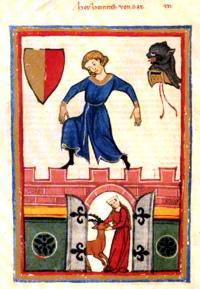
Origin of music for strings
Alpstobete * on Soll, 1865 by Emil Rittmeyer
(*An “Alpstobete” is a gathering in the mountains at which the inhabitants of the Alps come together to dance. Traditionally, these occasions would be held outdoors, but nowadays they also take place in restaurants.)
According to community scripts (e.g. from the year 1736), authorities would regularly intervene at these gatherings and fine the people responsible. At a traditional Alpstobete, people would dance in the open to the sound of the fiddle and the hammer dulcimer. The painting by Emil Rittmeyer (1865) shows an Alpstobete on Alp Soll, with violin and hammer dulcimer.
This two-person line-up was popular until mid 18th century, when the Basset or Bass was introduced.
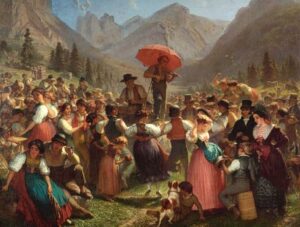
First widely known group of Appenzell
The first band that was known beyond the borders of the Appenzell region, was called: Quartett Appenzell (1860-1890/94)
The picture shows the String Quartett Appenzell in the year 1874:
Basset: Anton Maria Klarer, Schneteremarei, Enggenhütten
Violin: Ignaz Dörig, Ackergnazi, Hirschberg
Violin: Josef Anton Inauen, Badischtesebedoni, Weissbadstrasse
Hammer Dulcimer: Jakob Anton Knill, Fleck, Ried
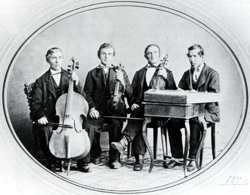
Heyday of string music (1890-1914)
Around the end of the 19th century, the groups mostly performed in the “original Appenzeller string music line-up: first violin, second violin, hammer dulcimer, cello and upright bass”. This started 1884 with the “Urnäscher Streichmusik” (later renamed to “Streichmusik Alder”); today the “Alder’s” continue playing music in their 5th generation.
1892 the “Streich-Quintett Appenzell” was founded. Its final line-up was defined before the end of the century and the band continued playing like this until WWI.
Around 1900 the “Streichmusik Schmid” of Walzenhausen joined them.
1913 Hans Rechsteiner founded the “Streichmusik Edelweiss Trogen” (changed to “Edelweiss Herisau” in 1986).
This style of music and compositions from that era have kept their validness and are still being played and cultivated by many musicians and bands.
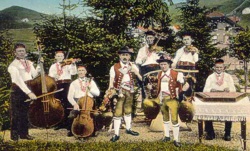
The influence of modern music (at that time), such as “Wienermusik & Tafelmusik” (Viennese music and table music) has also left its traces on present day Appenzeller music. It is not uncommon for a string group to insert a Viennese piece in their program.
Nowadays the original string music groups strike up rarely for a dance, but rather for a concert.
Representatives of this music are or were:
Streichmusik Alder, Streichmusik Schmid, Streichmusik Edelweiss Herisau, Streichmusik Hornsepp, Streichmusik Weissbad, Streichmusik Alperösli, Geschwister Küng, Frauestriichmusig, Streichmusik Bänziger, Toggenburger Original Striichmusig, Brandhölzer Striichmusig, Streichmusik Kalöi, and many more
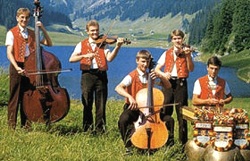
“Modernization” of Appenzeller music, preferably with the accordion
In the 50s and 60s the accordions popularity increased. Over time it even replaced the second violin and the cello and was more and more used as a leading instrument. Similarly the piano started to replace the hammer dulcimer. Hans Dörig (Urseles Hans) carried this version of the Appenzeller music with the accordion far beyond the borders of our country. Some of his most popular songs include: “im Pöschtli z’Appezöll” and “Rond om de Säntis”.
Today this style of music has returned to include again the hammer dulcimer or the piano (or both, as a trio or quartet).
Representatives of this style are:
Appenzeller Echo, Säntisgruess, Warth Buebe, Alphöttli, Quöllfrisch, Alpengruess Appenzell, Echo vom Schwendetal, Hersche Buebe, Setteretalbuebe, Alpsteebuebe, Waldstättergruess, Steerölleli, Dewiisli, and many more …
Due to the influence of entertainment- and other folklore music (such as accordion duets), some groups in Appenzell have started to specialize on that trend. Those bands mostly play with two accordions, piano and bass.
Representatives of this style are:
Promillos, Waldhöckler, Chaschte-Höckler, Kapelle Enzian, and many more …
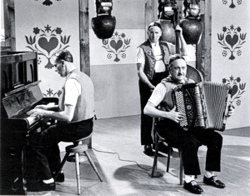
Further modernization of the Appenzell music
Other formations specialized in playing concertante Appenzell, table and salon music with violin, accordion, dulcimer (ev. piano) and bass.
In this instrumentation, a broader repertoire is usually played due to influences of salon and classical music: Viennese waltz, Gypsy music, Irish music, etc….
Music groups of this section are:
Alderbuebe, Appenzeller Echo, Altfrensch, Kapelle Kölbener, de Baazli mit sine Kollege, etc…
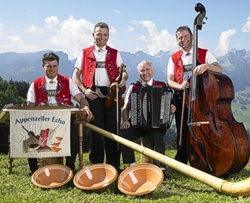
Sources: Johann Manser (Buch: Heemetklang us Innerrhode), Joe Manser, Zentrum für Appenzellische Volksmusik (Center
for Appenzeller Folk Music)
